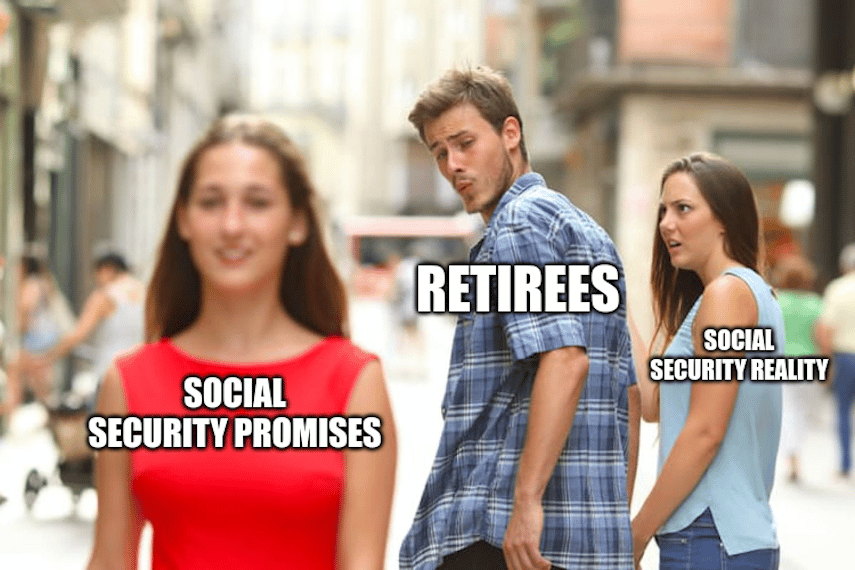
Although the Social Security system was originally intended only to provide a backstop to retirees who may not have had enough money saved up for retirement, the initial benefits received by Social Security recipients lured many people into a false sense of security, leading them to believe that they could survive in retirement solely on their checks from the government. Despite the continued erosion of benefits over the succeeding decades, and court rulings making it clear that Social Security benefits are not a promise from the government, there remain many Americans who believe not only that they are owed money from the government in retirement but that they will be able to survive and pay their expenses with those benefits. They couldn’t be any more mistaken.
Financial Projections May Be Too Rosy
With news of the President’s supposed dalliances with adult film stars and the alleged high school shenanigans of his Supreme Court nominee filling headlines and titillating the general public, Social Security and its problems have been relegated to the back pages of newspapers and the archive sections of websites. This year’s Social Security trustees’ report didn’t report anything groundbreakingly new compared to last year’s report, so everyone expects the system to go bankrupt precisely when the report says it will.
Let’s take a step back and refresh our understanding of how Social Security is funded. Employers and employees pay a portion of their salaries in Social Security taxes to the federal government to fund Social Security benefits. That means that it is a transfer system, taking money from workers and redistributing them to fund retirees.
For decades, the amount of money taken in through Social Security payroll taxes exceeded the amount of money paid out in benefits. That extra money was exchanged for non-marketable government securities that were kept in a trust fund, and the money was spent. The interest on the securities in the trust fund was also used to help pay for Social Security benefits, so despite the fact that Social Security taxes have been exceeded by Social Security benefits for nearly two decades, the trust fund has not had to be touched. Until now.
The sum of Social Security taxes plus interest on trust fund securities is now exceeded by the sum of Social Security benefits, and that financial situation will likely only continue to deteriorate as the trust fund has to be drawn down to pay for more and more retirees’ Social Security benefits. As the trust fund is drawn down, interest income decreases, and the likely future trend is for Social Security tax receipts to continue to decrease too. Current projections are for the Social Security trust fund to be completely drawn down by 2034, by which point Social Security taxes can only pay for about 75% of expected benefits.
Of course, all of this assumes a relatively rosy economic situation over the next 16 years. In the event of another financial crisis you could expect that Social Security tax receipts will decline by an even greater amount than projected, placing Social Security on an even weaker financial footing. The moral of the story, then, is not to expect anything near a full payout from Social Security. With so much kicking the can down the road having taken place already, there’s not really any time to get the program onto sound financial footing. The trust fund may very well end up running out of funds well before 2034, and any benefits paid out may be well less than 75% by that time.
COLA Doesn’t Keep Pace With Spending
The second problem with Social Security is its cost of living adjustments (COLA). The government continually tinkers with the data used to makes its COLA increases in order to minimize the amount of money the government has to pay. There was no COLA increase in 2016, a 0.3% increase in 2017, and a 2% increase in 2018. While it’s expected that COLA will increase 2.8% next year, there’s no guarantee that will happen, as the government would like to try to continue minimizing COLA payments to keep the program solvent. Even if it does happen, that means that someone who received $1,000 a month in 2015 will receive about $1,050 a month in 2019, or an increase of $600 per year. Given how much food, housing, and gas have increased in price over the past several years, that increase isn’t nearly enough to cover the actual increase in the cost of living.
Add healthcare into the mix and things get even worse. Healthcare costs vastly outstrip inflation and are expected to continue doing so into the future. And as you age, you’re going to need more and more medical care, driving costs up even further. Even a 5% annual COLA probably wouldn’t be enough to cover rising costs for most seniors.
What You Can Do
It’s more important than ever for Americans to develop their own safety nets for retirement. With the implosion of Social Security and the chronic underfunding of pension plans, those who don’t put away money for their retirement are playing a dangerous game of Russian roulette.
Part of that strategy of saving for retirement includes properly diversifying your portfolio so that you aren’t exposed to a single sector of the market. And that doesn’t mean plowing all of your money into a mixture of various stocks, either. Stocks, bonds, commodities, precious metals, real estate, and even cryptocurrencies all can form part of a well-diversified portfolio.
Precious metals in particular can form a strong part of a well-diversified portfolio, as they hedge against both inflation and financial downturn. Investors who placed 30% of their portfolios into gold before the financial crisis would have seen their portfolios outperform pure stock portfolios by 60% during the crisis.
Even if you haven’t done a great job of saving for your retirement yet, it’s never too late to start. Even a little bit of money saved and invested is better than having nothing. Once you’ve left the workplace it can be very difficult to find well-paying employment, so you can’t assume that you’ll even be able to find a part-time job to make ends meet once you’re retired. Don’t wait any longer, take the steps you need to today to make sure that you’ll be able to fulfill your retirement dreams.






